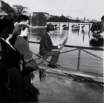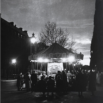Edouard Boubat was born in Paris in 1923. His childhood was spent in Montmartre, and he went on to study photoengraving at the Estienne academy. It was not until after the Second World War, in 1945, that he discovered photography. In 1946 he took the famous photograph “Petite fille aux feuilles mortes” with his first camera, a 6X6 Rolleicord. He met Lella, the woman who would become his muse, in 1947. In the same year, he won the Kodak prize. “Camera” magazine published him for the first time in 1950, during which year he took the photograph “L’arbre et la poule”, another image that has become emblematic of his work.
In 1951, Robert Delphire invited him to show his work at the La Hune bookshop in Paris, alongside Brassai, Doisneau, Izis and Fachetti. The prints caught the eye of Bertie Gilou, artistic director of the revue “Réalités”. This led to a long term collaboration between Edouard Boubat and the magazine. From 1952 to 1967, he traveled and took photographs around the world. He became an independent photographer once again in 1967, and collaborated with the Rapho press agency. In 1971, he was the guest of honor at the Rencontres dʼArles, where he obtained the Book Award in 1977 for “La survivance”. He received the National Grand Prize for Photography for his entire body of work in 1984, and the Hassleblad Foundation International Award in Photography in 1988.Edouard Boubat died on June 30th 1999, at the age of 75.
His photographs are part of many public and private collections.




















